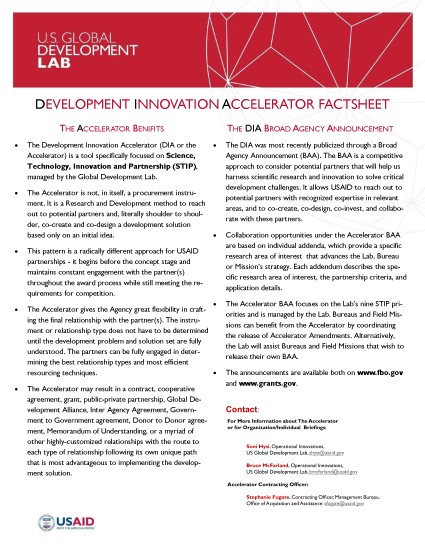Speeches Shim
THE ACCELERATOR BENEFITS
Development Innovation Accelerator Factsheet ![]() (pdf - 229k)
(pdf - 229k)
- The Development Innovation Accelerator (DIA or the Accelerator) is a tool specifically focused on Science, Technology, Innovation and Partnership (STIP), managed by the Global Development Lab.
- The Accelerator is not, in itself, a procurement instrument. It is a Research and Development method to reach out to potential partners and, literally shoulder to shoulder, co-create and co-design a development solution based only on an initial idea.
- This pattern is a radically different approach for USAID partnerships - it begins before the concept stage and maintains constant engagement with the partner(s) throughout the award process while still meeting the requirements for competition.
- The Accelerator gives the Agency great flexibility in crafting the final relationship with the partner(s). The instrument or relationship type does not have to be determined until the development problem and solution set are fully understood. The partners can be fully engaged in determining the best relationship types and most efficient resourcing techniques.
- The Accelerator may result in a contract, cooperative agreement, grant, public-private partnership, Global Development Alliance, Inter Agency Agreement, Government to Government agreement, Donor to Donor agreement, Memorandum of Understanding, or a myriad of other highly-customized relationships with the route to each type of relationship following its own unique path that is most advantageous to implementing the development solution.
THE DIA BROAD AGENCY ANNOUNCEMENT
- The DIA was most recently publicized through a Broad Agency Announcement (BAA). The BAA is a competitive approach to consider potential partners that will help us harness scientific research and innovation to solve critical development challenges. It allows USAID to reach out to potential partners with recognized expertise in relevant areas, and to co-create, co-design, co-invest, and collaborate with these partners.
- Collaboration opportunities under the Accelerator BAA are based on individual addenda, which provide a specific research area of interest that advances the Lab, Bureau or Mission’s strategy. Each addendum describes the specific research area of interest, the partnership criteria, and application details.
- The Accelerator BAA focuses on the Lab’s nine STIP priorities and is managed by the Lab. Bureaus and Field Missions can benefit from the Accelerator by coordinating the release of Accelerator Amendments. Alternatively, the Lab will assist Bureaus and Field Missions that wish to release their own BAA.
- The announcements are available both on www.fbo.gov and www.grants.gov.
ACCELERATOR STEP BY STEP TO AGREEMENT
STEP 1: The U.S. Global Development Lab (with the Bureau/Field Mission) posts a Broad Agency Announcement (BAA) on www.fbo.gov and www.grants.gov as a framework for participa-tion by parties that may want to collaborate with USAID in general research.
STEP 2: USAID posts a BAA addendum, calling for Statements of Interest from parties in a Research Area of Interest. The addendum includes the specific Research Area of Interest, partnership criteria, content requirements for Statements of Interest, and deadlines for submission.
STEP 3: USAID’s project office evaluates the statements of interest against the partnership criteria in the addendum and selects organizations to co-create a development solution.
STEP 4: USAID and the selected partners work together (the Co-Creation Team) to co-create a concept that includes the development problem, solution, the technical approach, areas of comparative advantage and general resourcing.
STEP 5: The Co-Creation Team presents the concept to the Lab’s Science-Peer Review Board, which will then make a recommendation to proceed to the next step of co-development based on whether the concept is in USAID’s strategic interest, has STIP merit, will provide results that can be measured, and is potentially scalable.
STEP 6: USAID management concurs in the project, linking the proposed project with the Lab, Bureau, or Mission’s strategy and identifying resourcing constraints, political considerations, or other general factors that may affect project design.
STEP 7: USAID’s Contracting/Agreement Officer (CO/AO) approves the project for co-development. The Co-Creation Team becomes the Co-Development Team. The CO/AO works continuously with the Co-Developers to advise/determine instrument and relationship types.
STEP 8: The Co-Development Team produces the project plan and resourcing requirements in suffi-cient detail to establish a formal relationship (contract, grant, MOU, or other instrument). The Team works together, shoulder to shoulder, to produce the required documents.
STEP 9: Concurrently with Step 8, the USAID members of the Co-Development Team complete any pre-obligation requirements, such as Project Appraisal Document amendments, Congressional Notifications, senior level approvals, etc. The non-USAID partners in the Co-Development Team may participate in many of these processes. CO/AO will conduct any pre-award deter-minations, such as pre-award surveys, determinations of responsibility, etc.
STEP 10: Once a consensus is reached and resources have been formally established, the parties come to agreement, instruments are formalized, and the implementation launches.


Comment
Make a general inquiry or suggest an improvement.